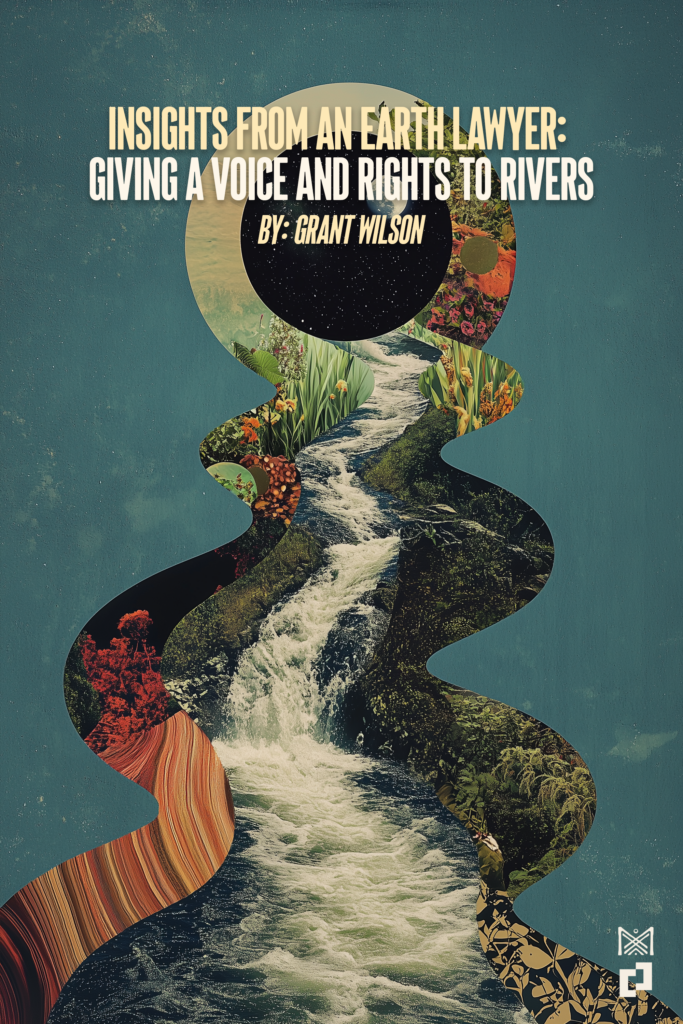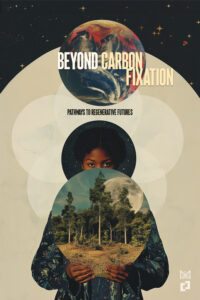Insights from an Earth Lawyer: Giving a Voice and Rights to Rivers
In a world grappling with ecological crisis, pioneering shifts in our legal systems are emerging as vital pathways to a sustainable future. This article introduces Earth law, a field centered on aligning human laws with Nature’s inherent rights and rhythms. Through prefigurative experiments, advocates are creating tangible examples of ecocentric governance that honor rivers, forests, and ecosystems as living entities with legal rights, rather than as resources to be exploited. These initiatives offer possibility models for the world we aspire to—a world where laws are built on principles of interconnection, restoration, and reciprocity. By embedding these values into policy and practice today, Earth law activists aren’t just theorizing change; they’re demonstrating it in real time, paving the way for a society that reveres rather than commodifies the natural world.
Grant Wilson is the Executive Director of the Earth Law Center.

As an Earth lawyer, my job is to help align human laws with the laws of Nature. Right now, most laws are based on the flawed belief that humans are separate from or superior to the natural world. Rivers, forests, and ecosystems are treated as commodities. Animals remain voiceless. Nature can only be defended in court when humans suffer an injury.
The law is created by humans, for humans.
But in reality, humans are just one small part of the larger interconnected web of life. Indigenous Peoples have long understood this truth, but it’s often forgotten—or ignored—in Euro-centric legal systems. However, it’s not too late to course correct. In fact, the urgency to do so has never been greater.
Imagine instead a new legal paradigm, reimagined to follow the natural rhythms of the universe, where law is rooted in interconnection, restoration, and reciprocity.
Imagine instead a new legal paradigm, reimagined to follow the natural rhythms of the universe, where law is rooted in interconnection, restoration, and reciprocity.
We call this field “Earth law”—like human rights law for the whole planet. It’s a branch of law that integrates Nature into the core of the legal system. This vision isn’t just theoretical; it is being grounded through prefigurative experiments worldwide—initiatives that embody Earth-centered values, actively modeling the legal systems we seek to create. The Rights of Nature, legal guardianship of Nature, criminalizing ecocide, and bioregional governance are among the ecocentric movements emerging as solutions to the ecological crisis.
These movements and others are an emerging reality. Across the world, hundreds of Earth-centered frameworks and policies now exist in dozens of countries. The movement is rapidly accelerating, meeting the urgency of the ecological crisis head-on.

The Rights of Rivers
The rights of rivers has been a focal point of the Rights of Nature movement. Rivers are not just the water between embankments; they are indicators of the health of entire watersheds. They are also living beings, deities, spirits, ancestors, and the lifeblood of our planet. Rivers are sacred.
Yet the law typically treats sacred rivers as resources. They are dammed, diverted, degraded, commodified—many are dying or already dead. Others are buried under layers of concrete, imprisoned and silenced. At what point does a river become so degraded that its essence, or spirit, is lost?
The rights of rivers movement aims to restore balance to our relationship with water. This movement, for example, is more than policy reform; it’s a possibility model that invites society to reimagine rivers as sacred beings rather than mere resources, restoring balance to our relationship with water. According to the Universal Declaration of the Rights of Rivers, rivers have a right to flow, to health, to be restored, and to have legal representation, amongst others.
The rights of rivers movement aims to restore balance to our relationship with water… Rivers have a right to flow, to health, to be restored, and to have legal representation, amongst others.
At Earth Law Center, we’re working with partners worldwide to advance these rights. Recently, the Nauta provincial court declared the rights of the Marañón River, a first for Peru, with this landmark victory held up on appeal, too. The river’s traditional Indigenous women defenders will now serve amongst its guardians. The mystical River Ethiope in Nigeria, bubbling up from the base of a giant silk cotton tree, is also a focal point of a burgeoning rights of rivers campaign.
These are just a few of the dozens of campaigns worldwide. Rivers are being given agency in the legal system, inspiring campaigns for other ecosystems, as well, such as rights for forests and even waves.
Accelerating Ecocentric Law
Despite this progress, much work remains to bring ecocentric laws into the mainstream, including for rivers. A few key ways to accelerate the movement include establishing national frameworks and through education.

1. National Laws
National laws lay the groundwork for transforming legal systems to bring them into harmony with Nature. Ecuador has the most robust Rights of Nature cases globally, with over 60 cases, largely because these rights are enshrined in its constitution. Panama’s recent Rights of Nature law has already been applied to protect sea turtles and halt destructive mining. National laws create a transformative impact, standing as the law of the land and difficult to override.
Every country now has an incredible opportunity to formally consider river rights and other Earth-centered frameworks through the Convention on Biological Diversity (CBD). Under the CBD’s new global biodiversity framework, countries must submit National Biodiversity Strategies and Action Plans (NBSAPs) detailing their approach to achieving the treaty’s overarching goals, including “living in harmony with Nature” by 2050.
Living in harmony with Nature by 2050 cannot be realized unless we align human laws and economic systems with Nature’s laws. Laws rooted in the destruction of Nature with stifle other efforts to restore the planet to health.
Living in harmony with Nature by 2050 cannot be realized unless we align human laws and economic systems with Nature’s laws. Laws rooted in the destruction of Nature with stifle other efforts to restore the planet to health.
Fortunately, thanks to Bolivia’s leadership, along with advocacy from Earth Law Center and many partners, the Global Biodiversity Framework now supports Rights of Nature and Mother Earth-centric actions—essentially, Earth law. As countries submit their NBSAPs, they have a low-barrier opportunity to explore these innovative approaches. Some countries have already highlighted Rights of Nature and ecocentrism in their NBSAPs as possible approaches to the biodiversity crisis, with many more having the potential to join them.
While under 40 countries have submitted NBSAPs so far, this leaves an enormous opportunity for growth. For this reason, Earth Law Center and partners are offering consultative services to interested governments. For example, a country might add a line in its NBSAP to explore harmonizing water laws with the intrinsic rights of rivers, and we can support that analysis.
For more details, see our report, Ecocentrism in the Global Biodiversity Framework. In addition to NBSAPs, it explores funding opportunities for ecocentric projects in developing countries, which could rapidly accelerate the movement.
2. Education
Education is also essential to accelerate the Earth law movement. Giving rivers and ecosystems a voice in the legal system requires specialized training. One of my greatest honors has been helping train over 500 people through our coursebook, Earth Law: Emerging Ecocentric Law. Many of them now lead campaigns to give rivers and ecosystems a voice and legal rights.
I believe every lawyer has a role in advancing Earth law. Constitutional lawyers can advance Nature’s fundamental rights. Family lawyers can support guardianship for Nature, not just children. Corporate lawyers can advocate for Nature to have its own board seats and voice in a company. Every area of law can be reinterpreted from an ecocentric perspective.
I believe every lawyer has a role in advancing Earth law… Every area of law can be reinterpreted from an ecocentric perspective.
For rivers, water rights lawyers, property and land use lawyers, and environmental lawyers can add their own expertise.
This push for Earth law education is gaining momentum. Harvard now teaches the Rights of Nature, and other schools are integrating Earth law into their curricula. Barry Law School has taught Earth law to a whole generation of students. To them, this is the new status quo. At Earth Law Center, our own summer course provides a deep dive into Earth law for the next generation of lawyers, activists, and policymakers.
Ultimately, Earth law should be a core part of first-year law education. Practicing lawyers, and even retirees, should learn Earth law, as well. After all, lawyers are part of Nature, too.
Ultimately, Earth law should be a core part of first-year law education… After all, lawyers are part of Nature, too.
This message is resonating beyond the legal field. The arts are amplifying it as well: The Animals’ Lawsuit Against Humanity, a new play based on the 1,000-year-old fable where animals sue humans, premiered at Climate Week NYC 2024. There are countless opportunities for creatives to work alongside lawyers, and culture informs law and vice versa. I encourage everyone to get involved.

Conclusion
We must evolve our societies into ecological ones, with laws, cultures, and economies rooted in interconnection with the environment and each other. Indigenous Peoples will continue to lead and, in many cases, act as Nature’s guardians in this movement. The rights of rivers in particular demand a shift from exploitation to reverence.
We must evolve our societies into ecological ones, with laws, cultures, and economies rooted in interconnection with the environment and each other.
At the recent global biodiversity talks, COP16, in Cali, Colombia, I had the opportunity to visit the nearby rights-bearing Pance River with colleagues. What began as a small trip for a handful of people grew to 45 of us, all paying our respects to this river—a living being, a subject of rights, a natural system worth protecting for its intrinsic value. Several of us waded into the river in our suits, reassuring the Pance that it has a team of Earth lawyers working to give it a voice.
Now is our opportunity to build a vision to live in harmony with Nature. Together, we can shift from exploitation to stewardship, from degradation to renewal, creating a future that respects both Nature and all life within it.
